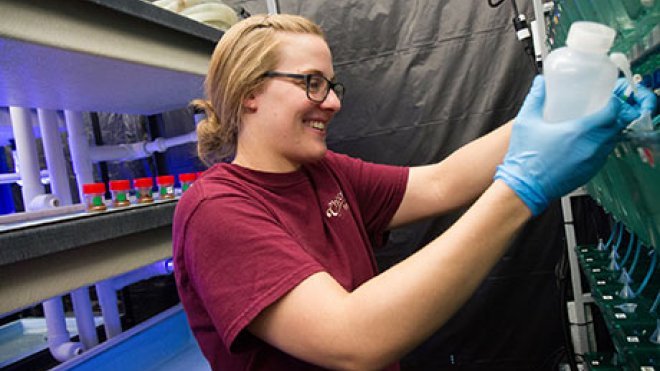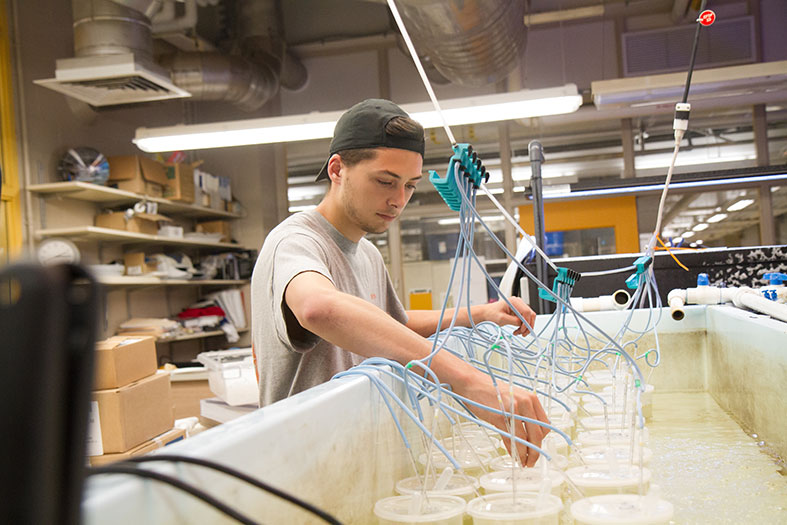Research Rundown: Innovative Science at the Wet Lab
A look at three students’ unique research projects that aim to advance marine science and improving the environment

BRISTOL, R.I. – It doesn’t matter what time of year, RWU’s Wet Lab thrums with life.
Stepping inside the aquaculture research facility feels like going behind the scenes of a renowned aquarium. A briny dampness saturates the air like warm bathwater. Seawater drawn directly from Mount Hope Bay supplies gurgling tanks and humming filtration systems, stacked in rows floor-to-ceiling. It’s here student researchers bustle among the maze of tanks, tending daily tasks of animal feeding, system maintenance and recording data on swarms of clownfish or fire shrimp nibbling on algae.
While students learn the foundation of science in the classroom, the Wet Lab is where they get to apply their research skills and gain real-world training as marine scientists and aquarists. With so many projects, ranging from breeding Yasha Gobies for the aquarium hobbyist trade to growing Atlantic Lookdowns and Smallmouth Grunts for Boston’s New England Aquarium exhibits, here are just three examples of innovative research students are doing inside the Wet Lab.
First in Fire Shrimp
Who at RWU: Erin Gaglias ’19 (marine biology major, with minors in aquaculture and aquarium science), Joe Szczebak (aquarium systems & design research associate), and Associate Professor of Marine Biology Andrew Rhyne
The Big Question: With no other researchers in the world attempting this, how do you raise Fire Shrimp to supply the aquarium trade?
In a Nutshell: A vital player in the health of coral reef ecosystems, the fire-engine-red crustaceans are highly sought after for hobbyist’s tanks and with all captured from the wild, evidence suggests their species are being exploited, Gaglias says. Building her own aquarium system to rear them from larvae to adults, Gaglias experiments with optimizing the shrimp’s first feedings, salinity and temperature levels for successful aquaculture. “If we can optimize the process for aquaculture in a lab, they can be raised on a larger scale, which would mitigate the need for taking them from the wild,” she says. “This isn’t just scientific research – it was also a cool engineering project. You have to be a carpenter and you have to be a plumber. I even make my own saltwater because the shrimp need a specific salinity.”
Tipping the Scale with Trout
Who at RWU: DaNelle Ellington ’19 (marine biology), Joe Szczebak (aquarium systems & design research associate), Casey Murphy (Senior Aquarist), and Associate Professor of Marine Biology Andrew Rhyne
The Big Question: What can farmers feed trout (and other fish farmed for human consumption) instead of more fish?
In a Nutshell: It takes an unsustainable amount of fish meal to nourish trout that feed the human population – about 5 grams of wild-harvested fish for every 1 gram of trout eaten by humans, says Ellington. Partnering with a Boston biotech company, RWU researchers are investigating a new, sustainable food source for farm-raised trout. The basis is a single-cell protein – but beyond that, it’s so groundbreaking that we can’t tell you what it is. “Fish are a major source of protein for the human population, and we’re growing and must keep up with the demand for a protein source,” she says. “With a 5-1 ratio, that’s a huge amount of fish we’re taking out of the ecosystem just to feed our food source. If this becomes mainstream, it would have a huge impact on our planet.”
Growing Sea-Monkeys
 Who at RWU: Liam Brosnahan ’19 (marine biology major, with minors in aquaculture and aquarium science), Joe Szczebak (aquarium systems & design research associate), and Associate Professor of Marine Biology Andrew Rhyne
Who at RWU: Liam Brosnahan ’19 (marine biology major, with minors in aquaculture and aquarium science), Joe Szczebak (aquarium systems & design research associate), and Associate Professor of Marine Biology Andrew Rhyne
The Big Question: Do sea-monkeys, a common first feed for larval fish, grow better in water with higher salinity, and, if so, can they be continuously produced instead of batch produced as they are now?
In a Nutshell: Artemia, tiny brine shrimp commonly known as sea-monkeys, are a huge staple in the aquaculture industry as a first feed for larval fish. Found in water with very high salinity, they are produced industrially at normal seawater salinity, Brosnahan says. So Brosnahan – after designing a siphon system to perform daily maintenance on the artemia – is trying to see if the sea-monkeys survive more in water that replicates their natural habitat. If so, he hopes to design an aquarium system that grows them at high salinity continuously as opposed to large batches. “Instead of doing a batch culture – which is basically growing a set amount of these artemia every set amount of days and harvesting over and over again – you would just have a continuous supply, which would really cut down on cost,” Brosnahan says.
At RWU, we develop Civic Scholars who believe in community-engaged work. That’s why we commit to providing every student an opportunity that empowers them to put their knowledge and skills to the test solving real-world problems and creating meaningful change with community partners. Learn more about the Civic Scholars program and how to help us reach our goal of every student participating in civic scholarship.